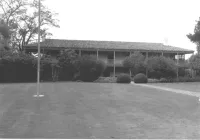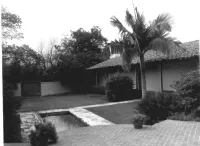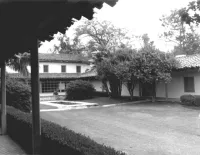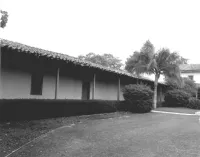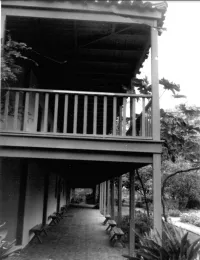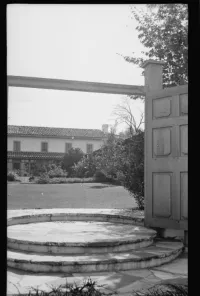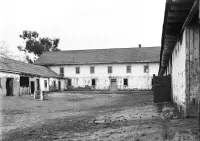Share what you know,
and discover more.
Share what you know,
and discover more.
Apr 15, 1970
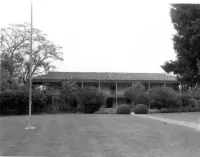
-

- Charmaine Bantugan
National Register of Historic Places - Los Cerritos Ranch House
Statement of Significance: Erected in 1844, this ranch house is an excellent example of the application of the Monterey Colonial Style to the traditional Spanish Mexican adobe ranch house. The building vac also the largest and most impressive adobe residence erected in southern California during the Mexican period. Los Cerritos Ranch house was built by Don Juan Temple, a former Bew Bng3ander, la 1B44 as the headquarters of his 27,000-acre ranch, The adobe house is built on the usual U-shaped plan around a large patio or courtyard which is enclosed on the fourth side by an adobe will. The central two-story portion, which contained the family residence, is 100 feet long and has a broad wooden tvo-story covered veranda across its front and around both ends. Behind ends of the central section are two one-story wings, each 145 feet long, which contained the storerooms, shape, and quarters for the Indian servants. The foundations are of baked red brick which were brought around the Horn by sailing ships. The hand-hewn beams in the house came from forests near Monterey. The adobe walls are 3 feet thick in the center section and about 2 feet thick in the wings. The original Brea or asphalt roof was replaced by a shingle roof in the 1860’s. The property was used aa a ranch until 1882 and then the adobe house was allowed to fall into disrepair. Restoration where began in 1930, when the existing tile roof was placed on the house. At the same time several of ta* original interior nails and ceilings in the central portion of the house were removed to cake to* rooms larger and higher. The restored bouse and about 4.5 acres of land are now open to the public as a historic house, museum, and city garden.
National Register of Historic Places - Los Cerritos Ranch House
Statement of Significance: Erected in 1844, this ranch house is an excellent example of the application of the Monterey Colonial Style to the traditional Spanish Mexican adobe ranch house. The building vac also the largest and most impressive adobe residence erected in southern California during the Mexican period. Los Cerritos Ranch house was built by Don Juan Temple, a former Bew Bng3ander, la 1B44 as the headquarters of his 27,000-acre ranch, The adobe house is built on the usual U-shaped plan around a large patio or courtyard which is enclosed on the fourth side by an adobe will. The central two-story portion, which contained the family residence, is 100 feet long and has a broad wooden tvo-story covered veranda across its front and around both ends. Behind ends of the central section are two one-story wings, each 145 feet long, which contained the storerooms, shape, and quarters for the Indian servants. The foundations are of baked red brick which were brought around the Horn by sailing ships. The hand-hewn beams in the house came from forests near Monterey. The adobe walls are 3 feet thick in the center section and about 2 feet thick in the wings. The original Brea or asphalt roof was replaced by a shingle roof in the 1860’s. The property was used aa a ranch until 1882 and then the adobe house was allowed to fall into disrepair. Restoration where began in 1930, when the existing tile roof was placed on the house. At the same time several of ta* original interior nails and ceilings in the central portion of the house were removed to cake to* rooms larger and higher. The restored bouse and about 4.5 acres of land are now open to the public as a historic house, museum, and city garden.
Apr 15, 1970
National Register of Historic Places - Los Cerritos Ranch House
Statement of Significance:Erected in 1844, this ranch house is an excellent example of the application of the Monterey Colonial Style to the traditional Spanish Mexican adobe ranch house. The building vac also the largest and most impressive adobe residence erected in southern California during the Mexican period.
Los Cerritos Ranch house was built by Don Juan Temple, a former Bew Bng3ander, la 1B44 as the headquarters of his 27,000-acre ranch, The adobe house is built on the usual U-shaped plan around a large patio or courtyard which is enclosed on the fourth side by an adobe will. The central two-story portion, which contained the family residence, is 100 feet long and has a broad wooden tvo-story covered veranda across its front and around both ends. Behind ends of the central section are two one-story wings, each 145 feet long, which contained the storerooms, shape, and quarters for the Indian servants.
The foundations are of baked red brick which were brought around the Horn by sailing ships. The hand-hewn beams in the house came from forests near Monterey. The adobe walls are 3 feet thick in the center section and about 2 feet thick in the wings.
The original Brea or asphalt roof was replaced by a shingle roof in the 1860’s. The property was used aa a ranch until 1882 and then the adobe house was allowed to fall into disrepair. Restoration where began in 1930, when the existing tile roof was placed on the house. At the same time several of ta* original interior nails and ceilings in the central portion of the house were removed to cake to* rooms larger and higher.
The restored bouse and about 4.5 acres of land are now open to the public as a historic house, museum, and city garden.
Posted Date
Sep 19, 2022
Historical Record Date
Apr 15, 1970
Source Name
National Register of Historic Places
Source Website
Delete Story
Are you sure you want to delete this story?
Mar 08, 1934
Mar 08, 1934
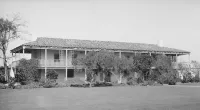
-

- Charmaine Bantugan
Los Cerritos Ranch House
Los Cerritos Ranch House, also known as Rancho Los Cerritos or Casa de los Cerritos, in Long Beach, California, was "the largest and most impressive adobe residence erected in southern California during the Mexican period". Los Cerritos means "the little hills" in English. It was declared a National Historic Landmark in 1970. History The structure, a Monterey Colonial adobe, was built in 1844 for merchant Jonathan Temple, a Yankee pioneer who became a Mexican citizen. The house was once the headquarters for a 27,000-acre (110 km2) ranch; the major activity on the ranch was cattle and sheep. The land was part of the 167,000-acre (680 km2) Rancho Los Nietos land grant to Manuel Nieto that was eventually divided into six parcels, one of which was Rancho los Cerritos. In 1843, Temple purchased the rancho and built the adobe house in 1844 as headquarters for his cattle operations. In 1866, Temple sold the rancho to Flint, Bixby & Company which converted the ranch from cattle to sheep. Jotham Bixby, the brother of one of the company's founders, managed and resided at the ranch from 1866 to 1881. Jotham Bixby, known as the "father of Long Beach", eventually purchased the property for himself and raised seven children at the adobe. One of Jotham's children who was raised at the ranch house was Fanny Bixby Spencer, who later became known as a philanthropist, poet, and pacifist. Beginning in the late 1870s, Bixby began leasing or selling portions of the ranch, which became the cities of Downey, Paramount and Lakewood. Between the 1880s and 1920, the adobe fell into disrepair. In 1929, Llewellyn Bixby (Jotham's nephew) purchased the property, and made extensive renovations to the house, including plaster cement coating, a new red-tiled roof, electricity, plumbing, fireplaces, a sun porch, new floors and much of the landscaping. Llewellyn Bixby died in 1942, and the family sold the house to the City of Long Beach in 1955. The City turned the house into a museum dedicated to educating the public about California's rancho period. Operation as a museum Rancho Los Cerritos Historic Site was converted into, and remains, a public museum operated by the Rancho Los Cerritos Foundation in partnership with the City of Long Beach. It is open for tours, programs and events on Wednesdays through Sundays. The house is furnished in a Victorian fashion as it would have been when Jotham Bixby raised his family there in the 1870s. There is a visitor center with exhibits about the site's history from Native American times to the present. A formal Italian garden includes orange and cypress trees planted by Temple. The center also features a 3,000-volume California history research library and a gift shop. The Friends of Rancho Los Cerritos support the museum and its activities.[citation needed] The museum was closed for 17 months from 2001–2002 to allow for seismic retrofitting, removal of lead paint and asbestos insulation, brickwork repairs and modifications to improve accessibility for the disabled.
Los Cerritos Ranch House
Los Cerritos Ranch House, also known as Rancho Los Cerritos or Casa de los Cerritos, in Long Beach, California, was "the largest and most impressive adobe residence erected in southern California during the Mexican period". Los Cerritos means "the little hills" in English. It was declared a National Historic Landmark in 1970. History The structure, a Monterey Colonial adobe, was built in 1844 for merchant Jonathan Temple, a Yankee pioneer who became a Mexican citizen. The house was once the headquarters for a 27,000-acre (110 km2) ranch; the major activity on the ranch was cattle and sheep. The land was part of the 167,000-acre (680 km2) Rancho Los Nietos land grant to Manuel Nieto that was eventually divided into six parcels, one of which was Rancho los Cerritos. In 1843, Temple purchased the rancho and built the adobe house in 1844 as headquarters for his cattle operations. In 1866, Temple sold the rancho to Flint, Bixby & Company which converted the ranch from cattle to sheep. Jotham Bixby, the brother of one of the company's founders, managed and resided at the ranch from 1866 to 1881. Jotham Bixby, known as the "father of Long Beach", eventually purchased the property for himself and raised seven children at the adobe. One of Jotham's children who was raised at the ranch house was Fanny Bixby Spencer, who later became known as a philanthropist, poet, and pacifist. Beginning in the late 1870s, Bixby began leasing or selling portions of the ranch, which became the cities of Downey, Paramount and Lakewood. Between the 1880s and 1920, the adobe fell into disrepair. In 1929, Llewellyn Bixby (Jotham's nephew) purchased the property, and made extensive renovations to the house, including plaster cement coating, a new red-tiled roof, electricity, plumbing, fireplaces, a sun porch, new floors and much of the landscaping. Llewellyn Bixby died in 1942, and the family sold the house to the City of Long Beach in 1955. The City turned the house into a museum dedicated to educating the public about California's rancho period. Operation as a museum Rancho Los Cerritos Historic Site was converted into, and remains, a public museum operated by the Rancho Los Cerritos Foundation in partnership with the City of Long Beach. It is open for tours, programs and events on Wednesdays through Sundays. The house is furnished in a Victorian fashion as it would have been when Jotham Bixby raised his family there in the 1870s. There is a visitor center with exhibits about the site's history from Native American times to the present. A formal Italian garden includes orange and cypress trees planted by Temple. The center also features a 3,000-volume California history research library and a gift shop. The Friends of Rancho Los Cerritos support the museum and its activities.[citation needed] The museum was closed for 17 months from 2001–2002 to allow for seismic retrofitting, removal of lead paint and asbestos insulation, brickwork repairs and modifications to improve accessibility for the disabled.
Los Cerritos Ranch House
Los Cerritos Ranch House, also known as Rancho Los Cerritos or Casa de los Cerritos, in Long Beach, California, was "the largest and most impressive adobe residence erected in southern California during the Mexican period". Los Cerritos means "the little hills" in English. It was declared a National Historic Landmark in 1970.History
The structure, a Monterey Colonial adobe, was built in 1844 for merchant Jonathan Temple, a Yankee pioneer who became a Mexican citizen. The house was once the headquarters for a 27,000-acre (110 km2) ranch; the major activity on the ranch was cattle and sheep.
The land was part of the 167,000-acre (680 km2) Rancho Los Nietos land grant to Manuel Nieto that was eventually divided into six parcels, one of which was Rancho los Cerritos. In 1843, Temple purchased the rancho and built the adobe house in 1844 as headquarters for his cattle operations. In 1866, Temple sold the rancho to Flint, Bixby & Company which converted the ranch from cattle to sheep. Jotham Bixby, the brother of one of the company's founders, managed and resided at the ranch from 1866 to 1881. Jotham Bixby, known as the "father of Long Beach", eventually purchased the property for himself and raised seven children at the adobe. One of Jotham's children who was raised at the ranch house was Fanny Bixby Spencer, who later became known as a philanthropist, poet, and pacifist.
Beginning in the late 1870s, Bixby began leasing or selling portions of the ranch, which became the cities of Downey, Paramount and Lakewood. Between the 1880s and 1920, the adobe fell into disrepair. In 1929, Llewellyn Bixby (Jotham's nephew) purchased the property, and made extensive renovations to the house, including plaster cement coating, a new red-tiled roof, electricity, plumbing, fireplaces, a sun porch, new floors and much of the landscaping. Llewellyn Bixby died in 1942, and the family sold the house to the City of Long Beach in 1955. The City turned the house into a museum dedicated to educating the public about California's rancho period.
Operation as a museum
Rancho Los Cerritos Historic Site was converted into, and remains, a public museum operated by the Rancho Los Cerritos Foundation in partnership with the City of Long Beach. It is open for tours, programs and events on Wednesdays through Sundays. The house is furnished in a Victorian fashion as it would have been when Jotham Bixby raised his family there in the 1870s. There is a visitor center with exhibits about the site's history from Native American times to the present. A formal Italian garden includes orange and cypress trees planted by Temple. The center also features a 3,000-volume California history research library and a gift shop. The Friends of Rancho Los Cerritos support the museum and its activities.[citation needed]
The museum was closed for 17 months from 2001–2002 to allow for seismic retrofitting, removal of lead paint and asbestos insulation, brickwork repairs and modifications to improve accessibility for the disabled.
Posted Date
Sep 19, 2022
Historical Record Date
Mar 08, 1934
Source Name
Wikipedia
Source Website
Delete Story
Are you sure you want to delete this story?


